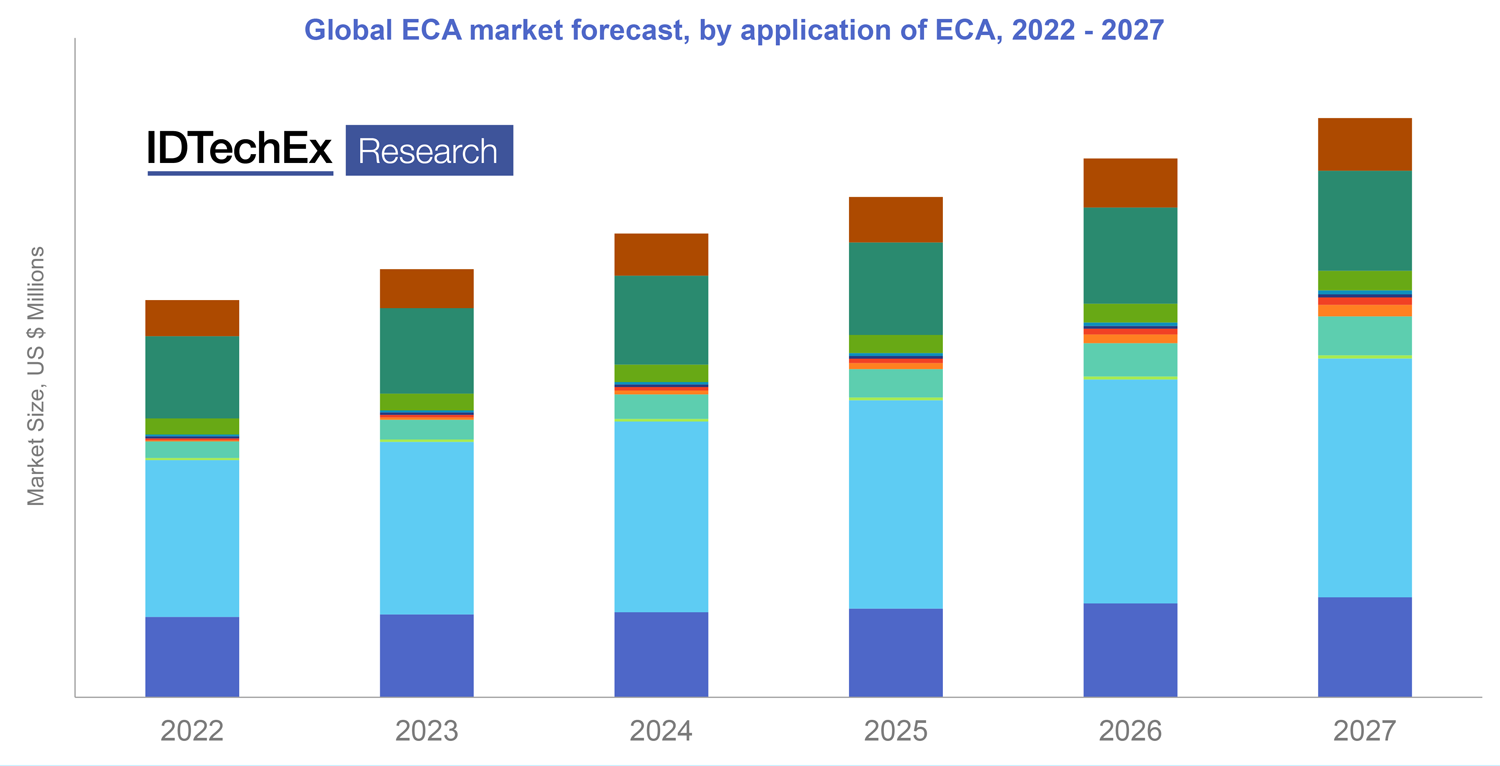IDTechEx have recently launched "Electrically Conductive Adhesives 2022-2032: Technologies, Markets, and Forecasts", a market research report detailing the technology of ECAs, a form of conductive joining technology. Electrically conductive adhesives (ECAs) are a growing competitor to lead-free solders and silver sintering technologies, and currently see use in several electronics applications, such as automotive electronics, consumer electronics, and display applications.
 IDTechEx has forecast the Global ECA market value, divided by application, between 2022 and 2032. The figure above shows a section of this forecast. Source: IDTechEx "Electrically Conductive Adhesives 2022-2032: Technologies, Markets, and Forecasts"
IDTechEx has forecast the Global ECA market value, divided by application, between 2022 and 2032. The figure above shows a section of this forecast. Source: IDTechEx "Electrically Conductive Adhesives 2022-2032: Technologies, Markets, and Forecasts"
Electrically conductive adhesives "ECAs", as covered in the new IDTechEx report, are formed from a conductive filler material and a structural resin material. The conductive filler, typically a metal powder, creates a conductive bridge across a join. Meanwhile, the structural polymer resin holds the join together, and the filler particles in place. This new report identifies common filler materials choices, including silver, nickel, and gold, and discusses the merits of each for use in ECAs. Additionally, common polymer resin materials, including epoxy, silicone, and acrylics, are also highlighted in this report.
In addition to these traditional ECAs, IDTechEx has identified several critical developments in ECA production, new products and technologies which may grow to transform the market.
An example of one of the key benefits of ECAs is the low processing temperature; much lower than alternative choices, such as solders. This allows ECAs to be used with a wider range of substrate materials, including temperate-sensitive polymer substrates. This makes ECAs a good choice of conductive joining technology for flexible electronics applications. However, ECAs are not without their drawbacks. A key disadvantage is the high cost of raw materials required. This has impeded their widespread adoption in several applications - when other joining techniques can be used with the same effect, ECAs benefits may not outweigh the cost.
Key application areas for ECAs are divided into current technologies, which provide very large markets for this technology, and emerging technologies, which have smaller markets, but a lot more potential for growth. Examples of existing application sectors are in automotive and consumer electronics, as well as RFID and display applications. Examples of more emerging technologies which present great opportunities for ECAs are flexible, printed, and wearable electronics. Currently, ECAs may find use in products anywhere in our daily lives, from computer screens to phone circuit boards, and in the future, this may grow to encompass solar cells and even our clothes through wearable technologies.
The report also breaks down the implementation process for ECAs into its key stages and discusses the main considerations for each stage, such as different application techniques, and the importance of thermally curing an adhesive.
"Electrically Conductive Adhesives 2022-2032: Technologies, Markets, and Forecasts" contains key insights and commercial outlooks for ECAs, built upon primary interviews and product analysis. The report considers both isotropically conductive adhesives (ICAs) and anisotropically conductive adhesives (ACAs), analyzing them from both a technical and commercial point of view. The potential application areas for each type of adhesive are considered independently, as well as the difference in growth potentials, and future projections for these technologies.
This new IDTechEx report provides a comprehensive overview of the electrically conductive adhesive industry, including insight obtained from primary interviews with industry players, and analysis of commercially available ECA products. 10-year, granular, market forecasts are given for each application area, broken down both by application, and by the type of adhesives used.
With the potential to impact a wide range of emerging industries, ECAs could become a critical technology in the future, and preparation for their more widespread adoption may be key.